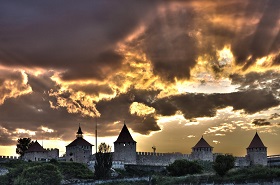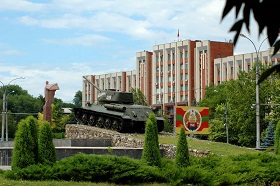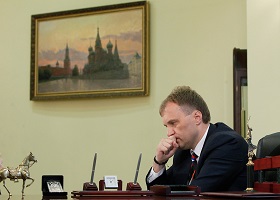Ukraine is Intensifying the Transnistria Conflict
(no votes) |
(0 votes) |
PhD in Political Science, Senior Lecturer, Department of Applied International Analysis, MGIMO University
The deteriorating relationship between Moscow and Kiev may be having profound regional consequences, with the Transnistrian Moldovan Republic (TMR) becoming a clear victim due to the abruptly worsening international environment. The Russian public has focused on the military aspects, although the problem is multidimensional and armed confrontation breaking out in Transnistria is unlikely.
The deteriorating relationship between Moscow and Kiev may be having profound regional consequences, with the Transnistrian Moldovan Republic (TMR) becoming a clear victim due to the abruptly worsening international environment. The Russian public has focused on the military aspects, although the problem is multidimensional and armed confrontation breaking out in Transnistria is unlikely.
A Moldovan-Ukrainian Coalition Emerges
Experts have been closely watching the TMR since last May when Ukraine terminated the agreement on the transit of Russian troops to Transnistria through its territory,[1] an unsurprising step given the fierce tensions between Moscow and Kiev. Ukrainian leaders will not continue to cooperate with the Kremlin in such a sensitive area, since they openly insist that they are in a state of war with Russia.[2] However, withdrawing the agreement raises questions about Kiev’s commitment to guaranteeing a Moldovan-Transnistrian settlement.
Chisinau is gaining more avenues to make the life of the peacekeepers even harder after transit through Ukraine was discontinued.
The decision was announced parallel to regular denials of entry to Russian citizens into Moldava, including servicemen.[3] Seemingly ready to allow the transit of peacekeepers to their positions with prior notification, Chisinau is demanding that the Russian contingent be replaced by international civilian observers,[4] and is gaining more avenues to make the life of the peacekeepers even harder after transit through Ukraine was discontinued.
Even more trouble seems to be in store concerning the task of reinforcing the Operative Group of Russian Forces in Transnistria, since Moldova is insisting on its removal. Chisinau is accusing Moscow of violating its obligations under the Istanbul compromise of 1999.[5] In turn, Russia is conditioning the possible reduction of its presence on progress being made towards reaching a settlement. At the same time, the conflict is eased due to the fact that the contingent numbers only about 1,000 servicemen, many of them recruits.[6]

Russia and the EU – Looking for Ways
of Cooperation in the Common Neighbourhood:
the case of the Republic of Moldova
and Transdniestria
The Russian military presence in the region is primarily symbolic and serves as a convincing guarantee that Moscow would automatically become involved if a direct military clash would erupt. In fact, the situation is reminiscent of the NATO forces deployed in West Berlin during the Cold War or today’s American contingent in South Korea. The contingent’s fighting capacity appears secondary, since the mission is mainly to ensure political containment.
The aggravated environment around the Russian force is resonating, with more dynamic military and political maneuvering by Moldova, something that is far from alleviating tension in the region. The last March Moldovan-Romanian-American exercise was quite belligerent, encroaching on the area of responsibility of the Russian peacekeepers.[7] Strains are also being fuelled by plans to establish a Moldovan-Romanian battalion[8] which could function as a mechanism for the de facto integration of Moldovan forces into NATO military infrastructure.
The Russian military presence in the region is primarily symbolic.
The parallel toughness of Kiev and Chisinau casts suspicions about coordinated action, substantiated by the visit last May of Moldovan Premier Cyril Gaburich to Kiev, where the two sides agreed to cooperate in settling the conflict.[9]
Memories of other frozen conflicts in the post-Soviet space do suggest a possibility of military provocations in the near future, although such a scenario is neither simple nor very probable. First, the sides are still militarily equal,[10] while Moldova’s mobilization potential is neutered by political dysfunction. Second, the Russian troops in the TMR render military pressure useless, even with the engagement of third parties, since Moscow will certainly respond in a tough way.
The parallel toughness of Kiev and Chisinau casts suspicions about coordinated action.
Recent events do not signal any preparations for a military annexation but rather a new wave of broad pressure on Tiraspol. As matter of fact, Chisinau and Kiev are trying to resolve very different problems. For Ukraine, Transnistria is a point of confrontation with Russia, while Moldova regards it as a honey-pot and a bargaining chip vis-à-vis Moscow. The interests of the two countries line up only in the context of hostility toward Russia and the expansion of EU ties, whereas in the strategic perspective, the commonality between their goals is limited.
Ukrainian Policy of Preventive Containment
The domestic troubles of Ukraine are so deep that the Moldovan track is obviously marginal, because Kiev must pool its resources for handling economic issues and its southeastern conundrum. However, the stakes are rising due to domestic dynamics and the sense of vulnerability to pro-Russian forces. Kiev would like to see the western border secure, since an additional conflict could break its backbone.
The situation in the Odessa Region, which borders Transnistria, hardly encourages optimism among Ukrainian leaders. The main risks are unrelated to pro-Russian sentiments,[11] because its residents do not wish a repeat of the Donbas scenario with armed clashes, destroyed infrastructure and bombing. A much greater threat lies in the poor governance of the strategic region.
Tougher policy from Kiev appears to be weakening the stance of Transnistria, which is short on territory and thus requires a stable hinterland.
Kiev regards the TMR as a source of often times indistinct fears about Russian influence on Odessa. The perception of a menace only partially correlates with the actions of Tiraspol. The avalanche of statements on Transnistria-related challenges emerged in summer 2014 and stabilized at a very high level after Mikheil Saakashvili was appointed governor of Odessa.[12] It is difficult to say whether propaganda or real fears are prevailing, but the trend has triggered the mechanism of the security dilemma, i.e. a kind of self-materializing prophecy based on mutual suspicion. Kiev’s alarmism has been substantiated by border incidents[13] and accusations about Russian drones.[14] In turn, Tiraspol is apprehensive of the destabilization caused by Ukrainian nationalists.[15]
Tougher policy from Kiev appears to be weakening the stance of Transnistria, which is short on territory and thus requires a stable hinterland. Tiraspol has actually fallen into the spiral of events, reducing its room for maneuver.
Risks of a Takeover Rising
The strategic position of Transnistria is deteriorating not so much in the military-political realm as in the economic one.
The strategic position of Transnistria is deteriorating not so much in the military-political realm as in the economic one. Moldova perceives the situation as an opening for embracing Transnistria and is trying to engage local businesses in order to taint Tiraspol and the very idea of independence. At the same time, attempts for a strategic swap are also possible: the alleviation of pressure on the TMR could be offered to Moscow in exchange for lifting the economic restrictions imposed after Moldova signed the Association Agreement with the European Union. Chisinau has been applying economic pressure on Transnistria with varying success over the past 15 years. Back in 2006, amidst a freeze in relations with Russia, Ukraine shut the border to Transnistrian exports.[16] Since that time, local enterprises wanting to enter foreign markets have had to register their goods as Moldovan.
The alleviation of pressure on the TMR could be offered to Moscow in exchange for lifting the economic restrictions imposed after Moldova signed the Association Agreement with the European Union.
The blockade has resulted in the gradual reorientation of Transnistrian firms from post-Soviet countries towards the EU. Trading with Russia has become more costly and more complicated logistically, while Brussels has offered easy access for Transnistrian goods on the basis of autonomous trade preferences. Beginning in 2008, TMR exports to the European Union surpassed those to Russia.[17] Today Brussels is insisting that Tiraspol shift its trade towards the format of the emerging deep and comprehensive free trade area with Moldova, with these effective preferences expiring on January 1, 2016.[18] As for Moldova, it is trying to exploit the situation in order to impose regulative control over Transnistrian enterprises.[19]
The Ukrainian crisis is making the life of Tiraspol much harder. Since consumer demand in Ukraine and Russia is falling, Transnistrian companies are losing their eastern markets. Moreover, in spring 2015, Kiev strengthened its blockade of Transnistrian exports by restricting Ukrainian supplies and the banning delivery of excised items to the TMR.[20] Transnistrian enterprises are operating under the threat of closure. The worsened external economic environment is generating a powerful multiplicative effect for this export-oriented and import-dependent country. Due to a budget deficit, in early 2015, the TMR had to freeze 30 percent of government employees' salaries and pensions.[21] The step was accompanied by pegging the local ruble to prevent a further drop in citizens' incomes. The policy is exhausting Tiraspol's currency reserves and undermining the competitiveness of local business given currency devaluations in key partner countries. Thus, the resources for maintaining political stability are contracting. In recent months, Transnistrian leaders have been insistently requesting Russian assistance.
Dilemmas for Pro-Russian Sentiments
The 2006 referendum showed the overwhelming willingness of the TMR population to complete a merger with Russia,[22] and the trend holds to date.[23] The population's identity is closely linked with the self-perception as being a part of Russian-language cultural space, despite the fact that Russians are only one of the three large ethnic groups in the republic.[24] This political proximity is bolstered by about 200,000 Transnistrians with Russian passports.[25] Under the current leadership, the drive toward Moscow has gained strength. Although the Kremlin supported the alternative candidate during the 2011 elections, President Shevchuk has proclaimed Eurasian integration as the Transnistrian national idea. Materially bolstered by Tiraspol's recognition of the transfer of Crimea to Russia, this policy has only made Kiev unhappier.
Moscow is ensuring both the military-political and the economic survival of the TMR, providing it with virtually free gas, direct financial aid and pensions for Russian citizens. Moreover, Russia-sponsored noncommercial organizations carry out numerous social projects covering the construction sector, as well as the renovation of hospitals, emergency rooms, kindergartens and other facilities.[26]
All historical and emotional ties with Transnistria notwithstanding, its importance primarily comes from competition with the West.
At the political level, Moscow is chanting the mantra of support to the TMR, with practical assistance remaining significant. Nevertheless, an adjustment of Russian policy to a new strategic environment seems timely. No doubt, all historical and emotional ties with Transnistria notwithstanding, its importance primarily comes from competition with the West. In addition, the Russian presence in the TMR is an instrument for containing the Greater-Romania plans of Bucharest and its influence on Chisinau.
Meanwhile, Russia's policy is not absolutely balanced. When relations between Moscow and Chisinau worsen, the containing component of the Transnistria conflict comes to the forefront, and Tiraspol receives more aid. However, Russia's sporadic attempts to attract Moldova towards a constructive partnership are never accompanied by a linking of preferences to a lessening of pressure on the TMR. As a result of this asymmetry, brief thaws between Moscow and Chisinau do not bring dividends to Tiraspol, while aggravations generate more restrictions. With time, the economic dependence of Transnistria on Russia will grow, but the effectiveness of the support rendered will fall, progressively failing to assuage the exacerbating difficulties. At the same time, Transnistria is constantly improving its economic ties with Moldova and the European Union.
Russian-Ukrainian relations present a key factor for the TMR survival.
There are additional complications for Moscow over the development of its approach due the need to regard Transnistria in the Ukraine context, because Russian-Ukrainian relations present a key factor for the TMR survival. The inclusion of Tiraspol into the bilateral conflict does not match the interests of Transnistria and Russia. For the length of the Moldova-Transnistria conflict, Ukraine's goodwill or neutrality for a long time served to maintain vital communications channels, whereas their destruction would bring damage far beyond military transit. Hence, the desecuritization of the Transnistrian-Ukrainian border acquires paramount importance.
Supported by Moscow, Transnistria in the short term will very likely retain its formal independence. Nevertheless, Tiraspol's policy may as well face some alternatives related to the difficulties to resist integration into the Moldovan economy. In the strategic perspective, the growth of a parallel dependence on Moscow, Chisinau and Brussels, followed by sharper competition between them may destabilize Transnistria. The state of domestic consolidation will be obviously displayed by the parliamentary elections this fall, as the vote will show the commitment of elites and the electorate to the idea of building their own statehood, as well as their readiness to suffer collateral economic damage.
[1] Poroshenko Signs Law on Abrogating Treaty on Transit of Russian Troops to Moldova. June 8, 2015. URL: http://tass.ru/mezhdunarodnaya-panorama/2027960 (in Russian)
[2] Ukraine's Poroshenko talks of 'real war' with Russia. BBC News. 20.05.2015. URL: http://www.bbc.com/news/world-europe-32805555
[3] Foreign Ministry: Moscow Concerned about Denial of Entry to Moldova for Russian Peacekeepers. URL: http://ria.ru/world/20150526/1066600083.html (in Russian).
[4] Aggravated Peacekeeping: Moldova Exploits Ukraine Crisis. URL: http://totul.md/ru/newsitem/589510.html (in Russian)
[5] Secrieru, Stanislav. The Transnistrian conflict – new opportunities and old obstacles for trust building (2009–2010) // Southeast European and Black Sea Studies 2011. 11 (3): 241–63.
[6] Felhengauer P. Transnistrian Contingent out at Feed // Novaya Gazeta. June 15, 2015.
[7] Moldovan and U.S. Servicemen Accused of Violating Security Zone at Dniester. URL: http://vz.ru/news/2015/4/10/739295.html (in Russian).
[8] Mukhin V. Moscow Prepares for Active Defense in Transnistria. URL: http://www.ng.ru/armies/2015-05-25/1_pridnestrovie.html (in Russian).
[9] Gaburich: Moldova Strengthens Ukraine Ties to Face New Threats and Challenges. URL: http://totul.md/ru/newsitem/755601.html. (in Russian).
[10] Felhengauer P. Transnistrian Contingent out at Feed // Novaya Gazeta. June 15, 2015. (in Russian).
[11] Explosive Pearl. NV Learns about Prevailing Sentiments in Odessa. URL: http://nv.ua/publications/vzryvnaya-zhemchuzhina-nv-vyyasnilo-kakie-nastroeniya-segodnya-preobladayut-v-odesse-40286.html (in Russian).
[12] Odessa Announces Measures to Counter Transnistria Smuggling. URL: http://nv.ua/ukraine/politics/-saakashvili-obeshchaet-vplotnuyu-zanyatsya-kontrabandoy-iz-pridnestrovya-51334.html (in Russian).
[13] Solovyov V. Transnistrian and Ukrainian Authorities Accuse each other of Border Shooting. URL: http://www.kommersant.ru/doc/2699052 (in Russian).
[14] Council for National Security and Defense Registers Drones Coming from Transnistria. URL: http://nv.ua/ukraine/SNBO-zafiksirovala-polety-bespilotnikov-so-storony-Pridnestrovya-5941.html (in Russian)
[15] Transnistrian President Eugeny Shevchuk Gives Interview to Russian TV Channels. URL: https://tv.pgtrk.ru/news/20140429/18838 (in Russian).
[16] Protsyk O. Moldova's Dilemmas in Democratizing and Reintegrating Transnistria. Problems of Post-Communism. 2006. 53 (4): 29–41.
[17] Shtansky N.V., Palamarchuk D.N., Kambur D.N. Transnistria Blockade: Survival Instead of Development. Between the Devil and the Deep Sea. Tiraspol: TMR MFA, 2014.
[18] Gamova S. Business Turns Transnistria to the EU // Nezavisimaya Gazeta. March 17, 2015.
[19] Magu V. KVINT Brandy under Pressure. URL: http://newspmr.com/novosti-pmr/proizvodstvo/13259 (in Russian)
[20] Ukraine Cutting Border Posts for Excised Goods Transit. URL: http://novostipmr.com/ru/news/15-03-27/ukraina-sokratit-chislo-pogranpunktov-dlya-perevozki-podakciznyh (in Russian).
[21] Sheremet P. The Life in Tongs // Ogonyok Magazine. June 22, 2015
[22] Shtansky N.V. Ukrainian Crisis and International Recognition of Transnistria // Diplomatic Bulletin. 2014. №1.
[23] Sheremet P. The Life in Tongs // Ogonyok Magazine. June 22, 2015
[24] Shtansky N. Handling the Identity Conflicts // International Processes. – 2014. - №1-2.
[25]Rogozin Offers Russian Citizenship to all Transnistrians. URL: http://www.gazeta.ru/politics/news/2015/07/01/n_7338809.shtml
[26] Alexander Argunov and Nina Shtansky Tell Russian Radio Station about Russian Humanitarian Assistance to Transnistria. URL: http://eurasianintegration.ru/?q=node/522
(no votes) |
(0 votes) |






